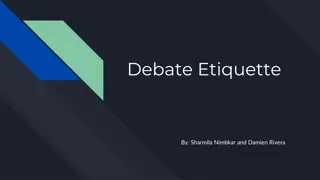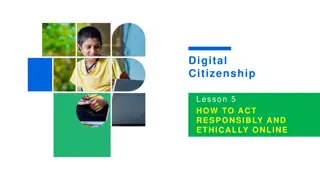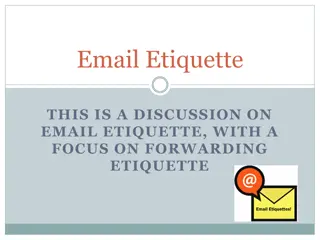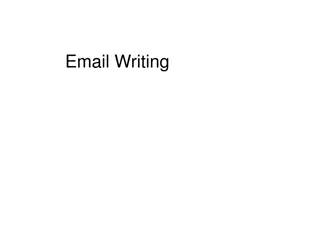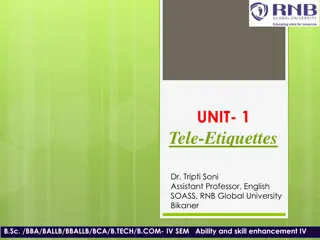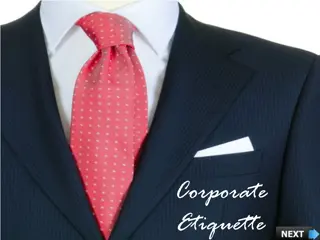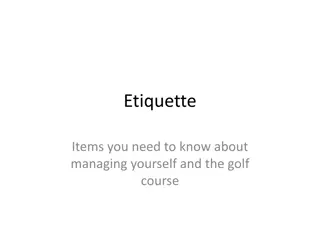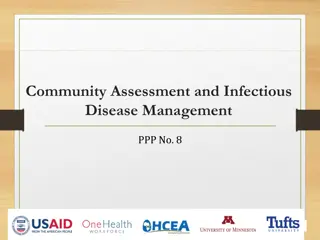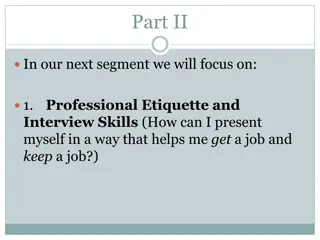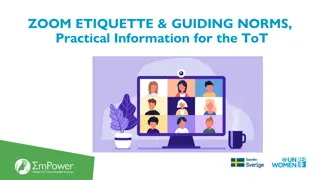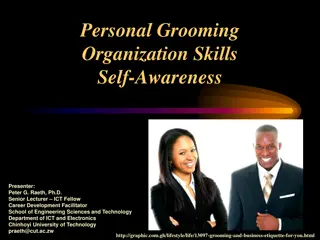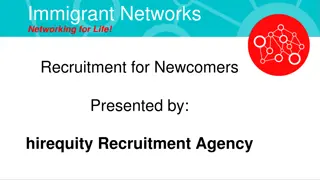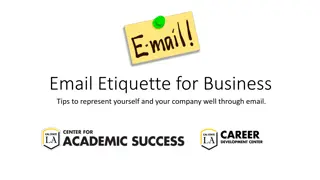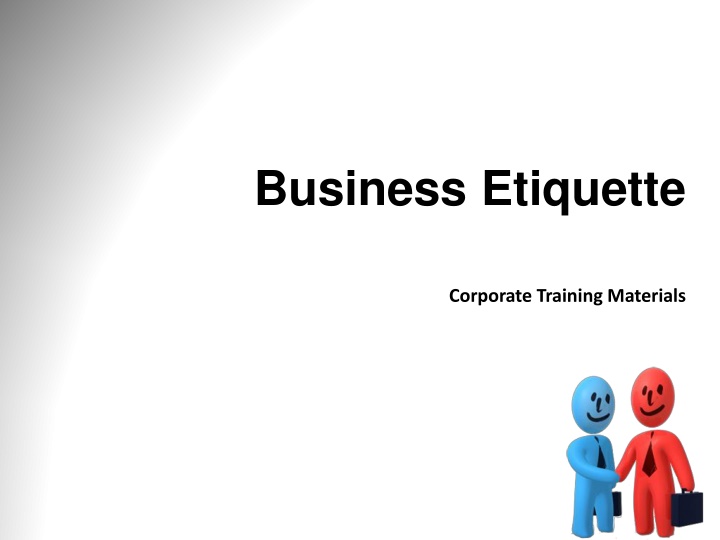
Essential Business Etiquette Training
In corporate environments, manners play a crucial role in building lasting relationships and enhancing success. This training program covers etiquette fundamentals, importance in business, and practical applications through modules and interactive activities. Participants learn to define etiquette, foster international relations, and uphold professionalism effectively.
Download Presentation

Please find below an Image/Link to download the presentation.
The content on the website is provided AS IS for your information and personal use only. It may not be sold, licensed, or shared on other websites without obtaining consent from the author. If you encounter any issues during the download, it is possible that the publisher has removed the file from their server.
You are allowed to download the files provided on this website for personal or commercial use, subject to the condition that they are used lawfully. All files are the property of their respective owners.
The content on the website is provided AS IS for your information and personal use only. It may not be sold, licensed, or shared on other websites without obtaining consent from the author.
E N D
Presentation Transcript
Business Etiquette Corporate Training Materials
Module One: Getting Started Manners are more important than laws. Manners are what vex or soothe, corrupt or purify, exalt or debase, barbarize or refine us Success in any industry relies on relationships, whether with co- workers, clients, suppliers, or investors. When you re well- mannered and considerate in dealing with others, you create engaging, productive, and long term business relationships. Edmund Burke
Workshop Objectives Define etiquette Minimize nervousness Remember names International etiquette
Pre-Assignment Review Think of some Business Activities you had in the month How I showed good manners/ professional courtesy in this situation What else I could have done to have expressed good manners/ professional courtesy.
Module Two: Understanding Etiquette Good manners can open doors that the best education cannot. Before we look at etiquette rules across multiple business-related scenarios, it s best to level off everyone on what etiquette means. We would also look at the many ways business etiquette can improve a company or an organization s bottom line. Clarence Thomas
Etiquette Defined Conventional rules of polite behavior Social interactions Communication Courtesy and hospitality
The Importance of Business Etiquette Branding Customer Care Employee Engagement Team Synergy
Module Two: Review Questions 1) Recognize the definition of business etiquette: a) Business etiquette is group of informal rules of general behavior. b)Business etiquette is a group of conventional rules of polite behavior. c) Business etiquette is a group of informal rules of polite behavior. d)Business etiquette is a group of non-conventional rules of behavior. 2) Which of the following IS NOT something that business etiquette covers? a) Courtesy b)Hospitality c) Self presentation d)Self confidence
Module Two: Review Questions 3) Which of the following IS NOT an area covered by the business etiquette? a)Employee engagement b)Team synergy c) Reconciling the feuded team members d)Customer care 4)Which of the following is one of the areas covered by the business etiquette? a)Product placement b)Product design c) Branding d)Advertising
Module Two: Review Questions 1) Recognize the definition of business etiquette: a) Business etiquette is group of informal rules of general behavior. b)Business etiquette is a group of conventional rules of polite behavior. c) Business etiquette is a group of informal rules of polite behavior. d)Business etiquette is a group of non-conventional rules of behavior. 2) Which of the following IS NOT something that business etiquette covers? a) Courtesy b)Hospitality c) Self presentation d)Self confidence
Module Two: Review Questions 3) Which of the following IS NOT an area covered by the business etiquette? a)Employee engagement b)Team synergy c) Reconciling the feuded team members d)Customer care 4)Which of the following is one of the areas covered by the business etiquette? a)Product placement b)Product design c) Branding d)Advertising
Module Three: Networking for Success You ve only got one chance to make a good first impression! When you re networking, it is important to make the most of the first meeting. In this module, we ll discuss how to create an effective introduction, make a good impression, minimize nervousness, use business cards effectively, and remember names. Anonymous
Creating an Effective Introduction Project warmth and confidence State your first name and your last name When the other person has given their name, repeat it in acknowledgment
Making a Great First Impression Confidence Competence Credibility
Minimizing Nervousness Be informed Believe in what you have to offer Practice! Practice! Practice! Identify your triggers Relaxation techniques
Using Business Cards Effectively Never be without one Follow protocol Time the presentation Accompany it with an explanation Value their card
Remembering Names Use mental imagery Repeat Put it on paper Use their name in creative sentences Be genuinely interested
Module Three: Review Questions 1)Which of the following IS NOT recommended as a part of an effective introduction? a)Projecting warmth and confidence b)Stating your position in the company c) Repeating the other person s name after the introduction d)Doing something memorable, e.g. making a certain gesture 2)In business, introductions are usually made based on: a)A person s seniority b)A person s seniority in a company c) Alphabetical order d)It is usually random
Module Three: Review Questions 3) For making a great first impression, you should avoid: a)Asking questions b)Making eye contact c) Using technical jargon d)Having a relaxed posture 4)The three C s for making a good impression stand for: a)Confidence, Contrasting, Care b)Confidence, Competence, Credibility c) Confidence, Contrasting, Credibility d)Confidence, Competence, Care
Module Three: Review Questions 5) Which of the following IS NOT a method of minimizing the nervousness? a)Visualizing b)Self-talk c) Being informed d)Being domineering 6)When it comes to the nervousness triggers, we should: a)Ignore them b)Suppress them c) Identify them d)None of the above
Module Three: Review Questions 7) When should you have your business cards with you? a) When you are at work b) When you are at work and when you are somewhere business related c) All the time d) When you remember to bring them there s no rule 8) Which of the following statements is true? a) You should give your card to the senior executives as often as you can, so you could get opportunities for a promotion b) You shouldn t give your card to the senior executives, unless they ask for one c) Giving a card to the senior executives is the same as giving it to anyone else d) There are no rules or limitations when it comes to giving the cards to the senior executives
Module Three: Review Questions 9) Which of the following IS NOT among the common ways of remembering a name? a)Using mental imagery b)Being genuinely interested c) Using name in a creative sentence d)All of the above are good ways of remembering a name 10)Which of the following statements IS NOT true? a)Remembering names is a skill b)Remembering names can be improved c) If you have troubles remembering a name, it s practically impossible to change it d)None of the above
Module Three: Review Questions 1)Which of the following IS NOT recommended as a part of an effective introduction? a)Projecting warmth and confidence b)Stating your position in the company c) Repeating the other person s name after the introduction d)Doing something memorable, e.g. making a certain gesture 2)In business, introductions are usually made based on: a)A person s seniority b)A person s seniority in a company c) Alphabetical order d)It is usually random
Module Three: Review Questions 3) For making a great first impression, you should avoid: a)Asking questions b)Making eye contact c) Using technical jargon d)Having a relaxed posture 4)The three C s for making a good impression stand for: a)Confidence, Contrasting, Care b)Confidence, Competence, Credibility c) Confidence, Contrasting, Credibility d)Confidence, Competence, Care
Module Three: Review Questions 5) Which of the following IS NOT a method of minimizing the nervousness? a)Visualizing b)Self-talk c) Being informed d)Being domineering 6)When it comes to the nervousness triggers, we should: a)Ignore them b)Suppress them c) Identify them d)None of the above
Module Three: Review Questions 7) When should you have your business cards with you? a) When you are at work b) When you are at work and when you are somewhere business related c) All the time d) When you remember to bring them there s no rule 8) Which of the following statements is true? a) You should give your card to the senior executives as often as you can, so you could get opportunities for a promotion b) You shouldn t give your card to the senior executives, unless they ask for one c) Giving a card to the senior executives is the same as giving it to anyone else d) There are no rules or limitations when it comes to giving the cards to the senior executives
Module Three: Review Questions 9) Which of the following IS NOT among the common ways of remembering a name? a)Using mental imagery b)Being genuinely interested c) Using name in a creative sentence d)All of the above are good ways of remembering a name 10)Which of the following statements IS NOT true? a)Remembering names is a skill b)Remembering names can be improved c) If you have troubles remembering a name, it s practically impossible to change it d)None of the above
Module Four: The Meet and Greet Ideal conversation must be an exchange of thought, and not, as many of those who worry about their shortcomings believe, an eloquent exhibition of wit or oratory. An introduction is almost always accompanied by a handshake and conversation. In this module, we would discuss the three steps that make an effective handshake and the four levels of conversation. Emily Post
The Three-Step Process Facial Expression Shake Hands Greet the Person
The Four Levels of Conversation Personal Feelings Viewpoints and Opinions Fact Disclosure Small Talk
Module Four: Review Questions 1)Which of the following IS NOT a part of the three- step process of handshaking? a)Facial expression b)Greeting the person c)Friendly tapping the shoulder d)All of the above are a part of the process 2)A good handshake should be: a)Lax b)Tight c)In between d)It doesn t matter
Module Four: Review Questions 3)The small talk stage implies: a)Telling some facts about you, such as your job or interests b)Exchange of pleasantries c)Exchange of the opinions d)Sharing viewpoints 4)Which stage is the hardest to get to? a)Small talk b)Fact disclosure c)Viewpoints and opinions d)Personal feelings
Module Four: Review Questions 5) In case study presented in the previous module, Patrick and Mindy start their conversation with: a) Small talks b)Fact disclosure c) Mix of those two stage d)Undefined stage 6) Decide the stage of the following Mindy s line: In fact when I heard that we re going again, I was a bit annoyed. a) Fact disclosure b)Viewpoints and opinions c) Personal feelings d)Small talk
Module Four: Review Questions 1)Which of the following IS NOT a part of the three- step process of handshaking? a)Facial expression b)Greeting the person c)Friendly tapping the shoulder d)All of the above are a part of the process 2)A good handshake should be: a)Lax b)Tight c)In between d)It doesn t matter
Module Four: Review Questions 3)The small talk stage implies: a)Telling some facts about you, such as your job or interests b)Exchange of pleasantries c)Exchange of the opinions d)Sharing viewpoints 4)Which stage is the hardest to get to? a)Small talk b)Fact disclosure c)Viewpoints and opinions d)Personal feelings
Module Four: Review Questions 5) In case study presented in the previous module, Patrick and Mindy start their conversation with: a) Small talks b)Fact disclosure c) Mix of those two stage d)Undefined stage 6) Decide the stage of the following Mindy s line: In fact when I heard that we re going again, I was a bit annoyed. a) Fact disclosure b)Viewpoints and opinions c) Personal feelings d)Small talk
Module Five: Dining in Style Whoever one is, and wherever one is, one is always in the wrong if one is rude. Maurice Baring Conducting business over meals is a great way to build business relationships. Meals make for a more casual atmosphere compared to offices, and are therefore more conducive for a relaxed discussion.
Understanding Your Place Setting Work your way inwards with the utensils Solids on the left, liquids on the right Follow the rule of three s.
Using Your Napkin Unfold your napkin and place it on your lap Place your napkin on your chair, if you leave the table Place to the left side of the plate when finished If dropped discreetly ask for another
Eating Your Meal Don t talk business during the meal proper, unless the senior members want to do so Take a cue from the host Try to pace yourself so that you can finish at the same time as everyone else Don t apply make-up, comb your hair while, or pick your teeth at the table
Sticky Situations and Possible Solutions You accidentally spilt food or drinks on a guest: Don t panic You ve noticed something in your food: Discreetly send it out to the server Inform host in advance of any dietary limitations
Module Five: Review Questions 1) What kind of atmosphere do the business meals make compared to the office? a) More private b)More casual c) More official d)More tense 2) Which of the following statements IS NOT true? a) Solids are on the left, liquids are on the right b)Forks are on right, knives and spoons are on the left of the plate c) Place settings differ depending on the menu and the formality of the dining event d)The oyster fork is always placed on right
Module Five: Review Questions 3) When do you unfold your napkin and place it on your lap? a) When you sit b) When everyone is seated c) When you start eating a meal which can cause you a mess d) Whenever you want, there is no special rule 4) Which of the following statements IS NOT true? a) If you leave the table during a dinner, you need to place your napkin on the table b) When you are finished dining, you should place your napkin neatly on the table to the left side of the plate c) If you drop your napkin on the floor, you should discreetly ask the waiter or host for another one d) Your napkin should remain on your lap throughout the entire meal
Module Five: Review Questions 5) When it comes to business, you: a) Shouldn t talk about it during the meal under any circumstances b) Shouldn t talk about it, unless the senior members want to do so c) Should talk about it, because that is the purpose of a business meal d) Can talk about it if you want, there are no rules or restrictions 6) Which of the following IS NOT considered rude during the meal? a) Picking your teeth b) Applying make-up c) Combing your hair d) Keeping your elbows off the table
Module Five: Review Questions 7) What is the best solution to the following sticky situation: A colleague is using the wrong utensil. a) You correct your colleague b) You try to indicate it to your colleague through a joke c) You try to let your colleague know it by using the right one yourself d) You ignore it 8) What is the best solution to the following sticky situation: You have put something in your mouth that doesn t agree with you. a) You swallow it no matter what b) You spit it in your spoon and put it on the edge of your plate c) You go to the bathroom and get rid of it there d) You ask the waiter for a napkin, discretely spit the food and place the napkin under a side of your plate
Module Five: Review Questions 1) What kind of atmosphere do the business meals make compared to the office? a) More private b)More casual c) More official d)More tense 2) Which of the following statements IS NOT true? a) Solids are on the left, liquids are on the right b)Forks are on right, knives and spoons are on the left of the plate c) Place settings differ depending on the menu and the formality of the dining event d)The oyster fork is always placed on right
Module Five: Review Questions 3) When do you unfold your napkin and place it on your lap? a) When you sit b) When everyone is seated c) When you start eating a meal which can cause you a mess d) Whenever you want, there is no special rule 4) Which of the following statements IS NOT true? a) If you leave the table during a dinner, you need to place your napkin on the table b) When you are finished dining, you should place your napkin neatly on the table to the left side of the plate c) If you drop your napkin on the floor, you should discreetly ask the waiter or host for another one d) Your napkin should remain on your lap throughout the entire meal
Module Five: Review Questions 5) When it comes to business, you: a) Shouldn t talk about it during the meal under any circumstances b) Shouldn t talk about it, unless the senior members want to do so c) Should talk about it, because that is the purpose of a business meal d) Can talk about it if you want, there are no rules or restrictions 6) Which of the following IS NOT considered rude during the meal? a) Picking your teeth b) Applying make-up c) Combing your hair d) Keeping your elbows off the table
Module Five: Review Questions 7) What is the best solution to the following sticky situation: A colleague is using the wrong utensil. a) You correct your colleague b) You try to indicate it to your colleague through a joke c) You try to let your colleague know it by using the right one yourself d) You ignore it 8) What is the best solution to the following sticky situation: You have put something in your mouth that doesn t agree with you. a) You swallow it no matter what b) You spit it in your spoon and put it on the edge of your plate c) You go to the bathroom and get rid of it there d) You ask the waiter for a napkin, discretely spit the food and place the napkin under a side of your plate
Manners are one of the greatest engines of influence ever given to man. Module Six: Eating Out In the previous module, we talked about etiquette guidelines relating to dining in style. In this module, we will look at basic courtesies to be observed while eating out, including guidelines in ordering in a restaurant, intake of alcohol during a business meeting, paying the bill and tipping. Richard Whately



